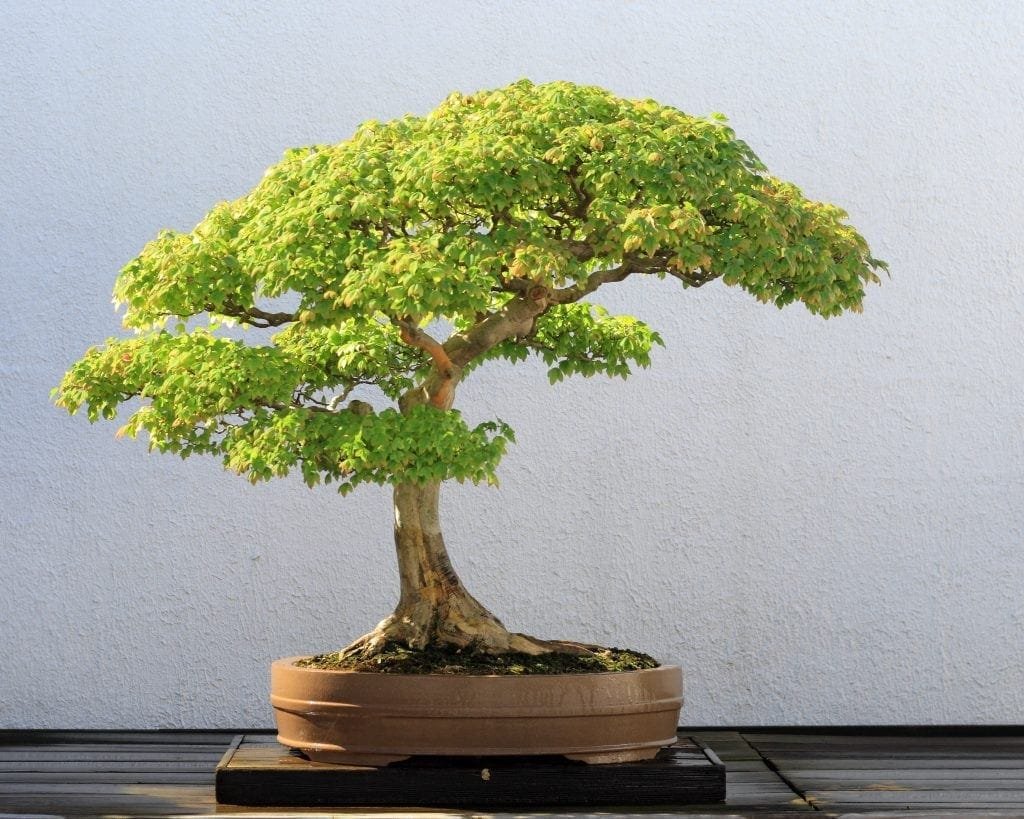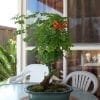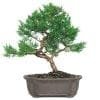Introduction To Outdoor Deciduous Bonsai Trees
Deciduous bonsai trees are those that have a cycle of dormancy and activity throughout the year. During the spring, summer and fall, these trees are in a normal state where they are completely fine with being kept outside. Most outdoor deciduous bonsai trees can be placed anywhere you want them to be as long as they receive fresh air, water, and sunlight.
However, deciduous bonsais enter a stasis period during the winter. They basically hibernate during this season. If you want to purchase a bonsai tree of the deciduous variety, ensure that you are ready to care for it. In the winter especially, you are going to need to exercise caution while taking care of the sleeping tree. Don’t panic if your tree sheds its leaves in the winter. This is entirely normal for a deciduous tree or plant.
As a bonsai grower and caretaker, you’re entering into a deal with the oldest name in the book – Mother Nature herself. Show the trees you buy the respect they deserve. They are truly beautiful, and as long as they are cared for in the right way, they will never let you down.
Deciduous Bonsai Trees
There are many more things you can do to ensure that your bonsai tree is flourishing in your home and garden. When you buy one of these trees, you are entering a contract with mother nature herself. Show the tree the respect it deserves, and you will be rewarded with beauty eternal! If you’re still looking for the best deciduous bonsai tree for you, why not check out some of these?
How To Care For Outdoor Deciduous Bonsai Trees
Bonsai tree care is a very fine art. If it isn’t done right, it could lead to the death of a very expensive purchase. A tree is a living creature, and the tiny bonsai needs your attention if you want it to thrive. A well-cared-for bonsai is a truly gorgeous sight to behold. There are some major steps you need to follow if you want your outdoor deciduous bonsai tree to stay alive, healthy and keep flowering for years to come.
Care
Location
Given the name, it’s pretty obvious where an outdoor deciduous bonsai tree needs to be placed: outdoors. During the spring, summer and fall, ensure that you keep the tree in your garden, in a spot where the sun shines on it almost constantly. If you live in an apartment and you got a bonsai tree for sale, just place it on your balcony. Don’t let it fall over, or there’ll be hell to pay. Whatever you do, do not keep your bonsai inside the house for more than a couple of days at a stretch.
When winter comes around you should take the bonsai tree inside. This isn’t for the tree’s benefit, but for yours. Ensure that it is in a dark, cool and dry place. The primary purpose of this is to deny sunlight to the tree. Since it sheds its leaves in the winter, the sunshine won’t do it any good at all. The temperature has to be cold, though, so make sure that the tree is either buried outside or in your garage. The cold temperature causes the onset of the tree’s hibernation period.
Water
A deciduous bonsai tree needs water. The soil in the pot always has to be a little wet. If you have placed your tree in sunlight, water it every day, or whenever the soil in the pot appears to be dry. You can’t just pour the water in and not care about how much, though. If too much water is poured into the soil, you wind up drowning the tree. It is small, and can’t take too much abuse. Don’t kill the beautiful thing – nurture it and let it thrive. You will soon, through experience, learn what the right amount of water is for your bonsai tree. Even when the tree sheds its leaves and goes to sleep for the winter, you should keep watering it, although not at the same rate as you did in the other seasons.
Fertilizer
You might not think it, but fertilizer is necessary for a little tree such as this one. In the winter when the tree is sleeping and not doing much growing, the use of fertilizer isn’t necessary. It won’t help the tree do anything. However, in the other three months (spring, summer, and fall) you should make an effort to fertilize the soil in the pot. Remember that a bonsai pot only has a tiny amount of soil in it. This soil doesn’t get any fresh nutrients through a natural cycle, so you need to replenish the content of the soil every now and then. Once a month is more than enough for this.
Repotting
Outdoor deciduous bonsai trees need to be transferred to a new home every couple of years. The soil in a pot can only last for so long before losing all of its nutrients. No amount of fertilizer will bring it back then. Changing the tree over to a new pot with fresh soil is an excellent way to rejuvenate your bonsai and give it added beauty over time.
Copper Beach Bonsai Trees
Description
The Copper Beech is also known by its alternative name – the Purple Beech. It is one of the most colorful types of deciduous bonsai trees out there. Known for its variety of colorful leaves throughout the year, this is definitely one of the best trees for any bonsai collector.
The leaves are typically a copper color in the springtime. This turns into a gorgeous green with tints of bronze in the summer, possibly due to the heat.
In the fall, the leaves turn a reddish brown (hence the name Purple Beech) and last for a lot longer than most others in the winter before falling off.
You should look for one that is about 10 years old, and which is about 18” in height for a gorgeous addition to your balcony or garden. You can find Copper Beech bonsai trees for sale here if you are interested!
Ginkgo Bonsai Trees
Description
This is also known as the maidenhair tree. The gingko tree yields one of the most commonly used spices in Chinese and Japanese culture. It is also a remnant of one of the oldest species of tree in the whole world.
There are fossils of full sized gingko trees that date back to about 200million years. Also known as the tree that is the equivalent of the fountain of youth, it boosts your health and helps you remember things easier.
The leaves of this little representation of an ancient legacy are fan-shaped and have two distinct lobes on them. While the leaves are typically green, they turn a deep, rich yellow color in the fall. Even better – it yields fruit!
These ripe, yellow clusters are an herbal remedy that can make you feel more at peace with the world than ever before. Look for one for sale that is 6 to 8 years old, and is about 17” tall. You can enjoy the mystical and amazing qualities of the mini Gingko bonsai tree by purchasing it here.
Trident Maple Bonsai Trees
Description
The maple is a deciduous bonsai tree that is known the world over for the gorgeous colors its leaves can assume over the course of the year. For example, in the fall this beautiful tree, a staple of Canada, has a rich, incredible red color to its leaves.
The bark is light brown and over time changes color into a grayish orange. One of the best features of this tree is that it can handle dry weather far better than most others. While you should always water your deciduous bonsais, forgetting to water the maple won’t lead to its death.
The leaves of this tree usually have 3 little lobes that are clustered together.
This is where the name Trident comes from.
It flowers in the springtime in a range of colors and is absolutely stunning during most of the year. The ideal deciduous trident maple, such as the one found here, would be 6-8 years old and about 10” in height.
Flowering Mini Rose Bonsai Trees
Description
The Mini Rose is exactly what you think it is. It is a gorgeous little rose plant that is one of the few flowering deciduous bonsai trees. It is available in a variety of colors such as red and yellow and has tiny green leaves that truly compliment how beautiful it is.
The yellow is the nicest of them all, in our professional opinion. The flowers are small and incredibly beautiful, blooming in the spring and not ceasing till it is almost winter.
In addition to this, most of the flowering bonsai trees for sale are resistant to a variety of diseases that their siblings can contract. Look for a tree that is about 5 years old, with 8” of height ideally. You can find one that is almost perfect right here.


